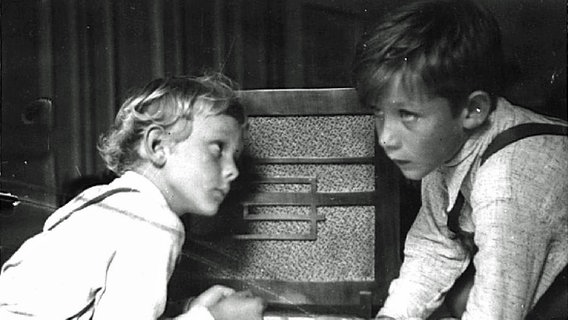It was with these words that Radio-Stunde AG, which later became Funk-Stunde AG, began broadcasting operations as the first public radio broadcaster in Germany. Entertainment radio was born. This brief announcement was followed by a one-hour opening concert. The technical prerequisites for wireless radio reception had been in place since before World War I. After the War, the German Foreign Office launched Wirtschaftsrundfunk business radio as the first regular talk radio in 1922.
Achtung, Achtung, this is the Berlin broadcasting station at Vox House on 400-meter-wave radio. Ladies and Gentlemen, we hereby inform you that today the radio entertainment service startswith the transmission of musical performances via wireless telephone channels. Use of the service is subject to authorization.
It then took another year before radio broadcasting was established for a broader public. With an eye on developments in the USA and other European countries, the Ministry of the Interior was afraid of the political impact the medium implied, most significantly misuse by subversives and the risk to the fragile cohesion of the nation from the influence of the different political parties.
Opportunity for distraction
Within a year, eight further broadcasting companies began operations alongside Funk-Stunde AG, and soon the entire territory of the German Reich was covered. From the outset, the new medium was supposed to be a neutral, apolitical and non-commercial entertainment service. Although private investors played a significant role in financing the regional companies, the state received an obligatory majority share in the relevant businesses.

The Vox building in Berlin, around 1923. Deutsches Rundfunkarchiv DRA, Image deutschlandfunk.de
One of the objectives set for radio was to consolidate the “Volksgemeinschaft” (community of the people), by integrating also the lower social classes into a German nation of culture. Therefore there was a focus on (cultural) education alongside entertainment, edification and instruction. This program of light entertainment also offered an opportunity for distraction from the grievances and day-to-day problems of modern life at that time. As the social-democratic newspaper Vorwärts remarked ironically:
But now we have the radio, so we stay at home and listen to the most delightful and pleasant things.
Since radio began as a provisional arrangement, there were initially no formulated rules and standards for the organization. Programming on a regional level developed quickly and very successfully, gaining its own momentum. During the first year, the program hours increased on average from three to eight hours a day. The official listener figures, including illegal listeners, grew continuously. By the end of 1925, over a million were registered.

The Guidelines for Regulation of Radio came into force only in 1926, and with them a multilayered control system. The special state service Deutsche Welle launched in the same year as the sole nationwide broadcaster. It provided educational programs, among other things, to broadcasting companies, but also adopted selected regional programs.
Relative freedom in programming
Despite certain limitations and the fact that, in absolute terms, the state possessed the monopoly on radio, there was relative freedom in programming – albeit firmly within the bracket of entertainment – and censorship was limited to individual programs, with no interventions in the organization or the staff involved. What developed was a pluralistic, multifaceted range of radio programs. The first people responsible for programming were primarily representatives from culture and journalism. Although none of the program directors were linked to any political parties, patriotic, national attitudes could be identified in various manifestations, which came in useful to the state.

Children listening to the radio, Image via: ndr.de
Radio became an important employer in the cultural sector, gaining an ever greater foothold in the cultural landscape, so that from the mid-1920s it was a veritable rival to cinema. As the social significance of radio as a mass medium grew, the public debates surrounding programming and alternative program ideas became ever more intense. People increasingly demanded the inclusion of current affairs. From 1928 the stations began broadcasting statements by important statesmen and political dialogs, albeit with certain parties excluded, most notably the Communist Party. Nevertheless, the printing press remained the key medium for conveying information and forming opinion.
Enforced conformity reaches radio
The continually developing pluralism was viewed critically by numerous, primarily anti-Republican forces. Censorship was considered too weak and the calls for a centrally controlled radio grew louder in a political climate that was shifting ever further to the right. In 1932, the newly elected government under Franz von Papen nationalized radio entirely, simplifying the organization, which really meant centralizing it, and ensuring the implementation of standardized guidelines through additional supervision.


Digitorial to the exhibition
The free digitorial provides you with background information about the key aspects of the exhibition "Splendor and Misery in the Weimar Republic"
For desktop, tablet and mobile
At the same time, many of those involved in radio who were considered unwelcome were dismissed. After the Nazis came to power, the exploitation and enforced conformity of the radio for propaganda purposes were further consolidated. The spread of the low-cost “Volksempfänger” radio meant that propaganda could be widely disseminated. While the number of listeners rose from four million in early 1932 to 16 million in 1943, the programming, which had been largely pluralistic and independent during the Weimar Republic, went in quite the opposite direction.